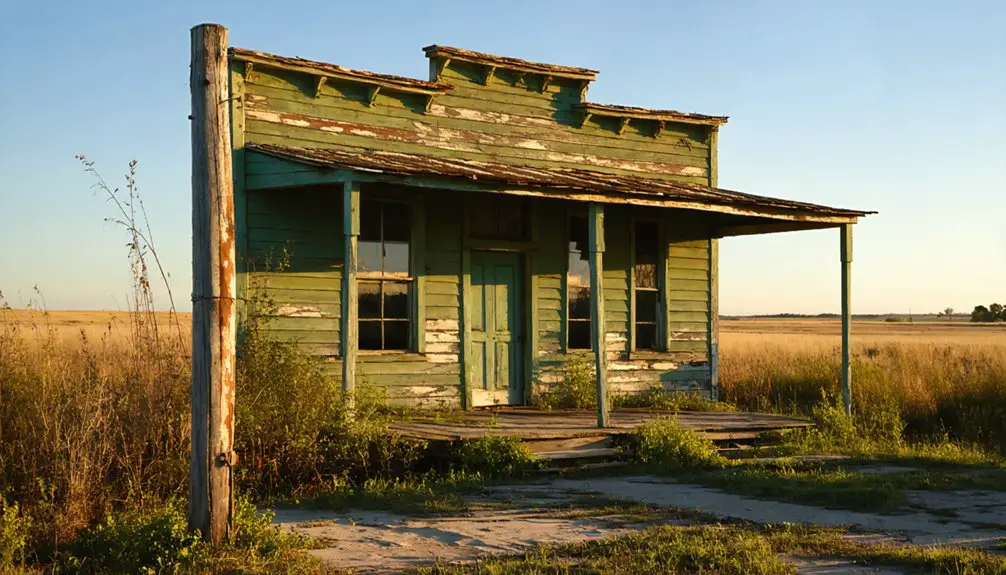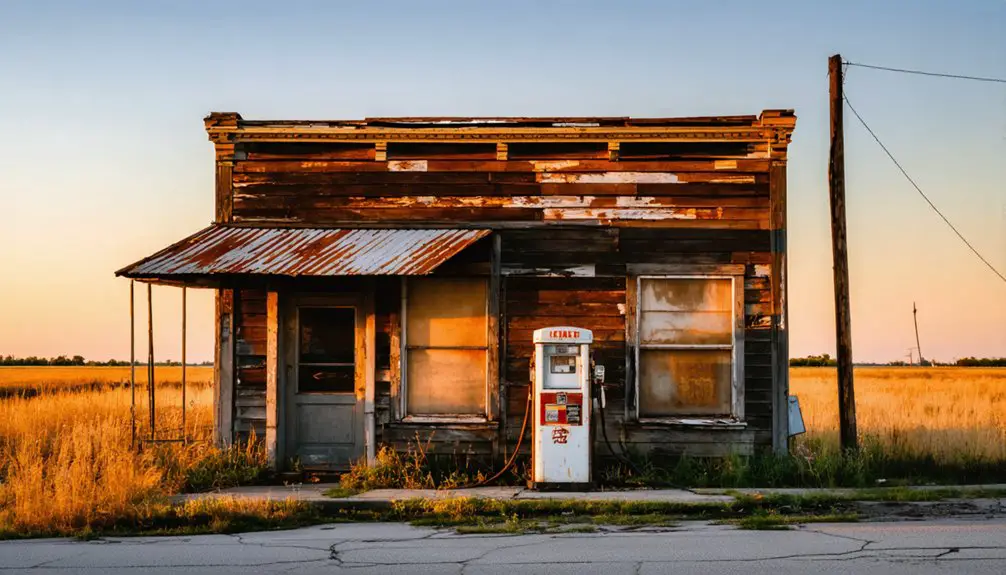You’ll find Manning, Oklahoma’s haunting remains where a bustling mining boomtown once thrived in the early 1900s. During its peak in the 1920s, over 14,000 miners extracted lead and zinc from the area’s rich deposits, creating a vibrant 24-hour community. Today, toxic chat piles and dangerous sinkholes mark the ghost town’s location, while contaminated groundwater and crumbling structures tell a cautionary tale of boom-and-bust mining’s lasting impact.
Key Takeaways
- Manning reached its peak in the 1920s with 18,000 residents, driven by lead and zinc mining operations.
- The town’s decline began with mineral depletion, mine closures, and decreased demand after World War II.
- Environmental hazards include toxic chat piles, contaminated groundwater, and 35 documented mine collapses since 1982.
- The abandoned town suffers from severe health and safety issues, including heavy metal contamination and dangerous sinkholes.
- Historical preservation efforts include collecting photographs, maps, oral histories, and artifacts from former residents.
The Rise of a Frontier Settlement
As the Oklahoma District opened for white settlement on April 22, 1889, nearly 100,000 enthusiastic settlers gathered at the northern border, poised to stake their claims in what would become one of America’s most dramatic land rushes.
On the cusp of Oklahoma’s historic land rush, masses of settlers lined the border, ready to race for their future.
If you’d lived through those early settler experiences, you’d have faced the intimidating task of transforming raw prairie into farmland while living in basic shelters.
Along the railroad lines, you’d have witnessed boomtowns spring up almost overnight, with places like Guthrie and Oklahoma City quickly establishing town governance. The U.S. Army established military forts and outposts to maintain peace among settlers and Native American tribes in the territory. Special agents investigated sooner claims to resolve disputed land titles and maintain order.
You’d have rubbed shoulders with ex-soldiers, entrepreneurs, and pioneer farmers, all seeking their slice of freedom on the frontier.
The landscape rapidly transformed as settlers built schools, businesses, and local governments, though this progress came at the expense of Native American communities who’d been forced to surrender their lands through federal treaties.
Mining’s Impact on Local Development
Mining transformed Manning’s destiny alongside many Oklahoma settlements in the late 19th century. You’d have witnessed rapid growth as coal, lead, and zinc operations generated enormous wealth throughout the region, attracting railroads and spurring infrastructure development.
The community dynamics shifted dramatically as company-owned houses and stores dominated the local economy. Miners found themselves struggling with debt to companies as they relied heavily on company stores for basic necessities. You’ll find that Manning’s proximity to southern Oklahoma’s mining boom brought both opportunities and challenges. The area was part of eastern Oklahoma’s counties where extensive coal mining operations flourished.
While mining regulations were limited before statehood in 1907, the change from private mining fiefdoms to more structured oversight changed how these towns operated. Labor movements gained strength, pushing back against mining barons’ control, while workers demanded better conditions.
The Missouri, Kansas and Texas Railway’s arrival enhanced trade connections, though Manning also faced the environmental and health burdens common to mining communities.
Daily Life in Manning’s Peak Years
While Manning reached its zenith in the 1920s, you’d have found a bustling town teeming with over 14,000 miners and 4,000 support workers going about their daily routines.
You’d witness miners trudging to their demanding shifts while others returned home, all part of the town’s round-the-clock operations. The crowded residential areas kept workers close to the mines, though some commuted via trolley from neighboring towns. The area’s massive ore deposits yielded 248 operating mills by 1927.
After shifts ended, you’d find the town’s social spirit alive in saloons and dance halls, where community gatherings helped ease the strain of grueling work days. Like many Oklahoma towns of the era, Manning served as one of the state’s numerous mining boomtowns that emerged following resource discoveries.
Weary miners found solace in Manning’s vibrant saloons and dance halls, where camaraderie helped lighten their daily burdens.
Despite the cramped living conditions and basic infrastructure, recreational activities flourished among the mostly male workforce.
The railroad’s constant movement of ore and supplies kept Manning’s lifeblood flowing, connecting it to the wider region.
Economic Forces Behind the Exodus
The discovery of rich lead and zinc deposits on Harry Crawfish’s allotment in 1913 sparked Manning’s meteoric rise, but the town’s fate would ultimately mirror the finite resources beneath its soil.
As you’d expect in any boom town, the gradual depletion of mineral deposits triggered an inevitable economic migration. The once-bustling mines that employed over 14,000 workers began closing as resource scarcity made extraction unprofitable. Acidic water contamination from abandoned mines further devastated the area’s prospects.
Similar to how railroad routing determined the survival of many Oklahoma towns, Manning’s isolation from major transportation corridors accelerated its decline.
You couldn’t escape the compounding challenges: restricted Quapaw tribal land ownership complicated new development, while toxic mine tailings and dangerous subsidence made much of the area uninhabitable.
The environmental toll, combined with plummeting demand for lead and zinc after World War II, sealed Manning’s destiny. Like many Oklahoma towns built on natural resource extraction, Manning couldn’t survive when its economic foundation crumbled.
Environmental Legacy and Health Concerns
Long after Manning’s mines fell silent, a deadly environmental legacy continues to plague the region through toxic chat piles towering up to 200 feet high.
You’ll find these mountains of mining waste, containing lead, zinc, and other heavy metals, contaminating the air you breathe and the water you drink. The toxic exposure has led to devastating health disparities, with children suffering from cognitive delays, hearing loss, and stunted growth. Ten to twelve hours of daily exposure to these hazardous conditions was once common for miners working in confined spaces. Government studies found that 34 percent of children tested positive for dangerous lead levels in their blood.
When the abandoned mines flooded in 1967, contaminated water turned Tar Creek orange, killing aquatic life and poisoning groundwater supplies.
Today, you’re facing a complex web of environmental hazards – from lead-laden dust that blows through town to contaminated soil in residential areas.
Despite ongoing cleanup efforts, you’ll likely see the effects of this mining disaster impact the region for generations to come.
Remnants and Ruins Today
Today you’ll find a haunting landscape where Manning’s bustling mining town once stood, marked by towering chat piles and scattered ruins.
These ghost town aesthetics are dominated by roughly 120 million tons of mining waste that still needs remediation, creating an eerie backdrop of industrial decay.
You won’t see many buildings anymore – most were demolished after official buyouts. Only a handful of structures remain, including the Quapaw Marshal’s Office.
The ground beneath your feet isn’t stable, with over 35 documented mine collapses since 1982 creating dangerous sinkholes.
Hidden beneath Manning’s surface lies a treacherous network of failing mines, ready to swallow the earth without warning.
Nature’s slowly reclaiming the empty lots where homes once stood, but the mining relics tell a sobering story. Cracked roads, abandoned utility poles, and contaminated soil serve as stark reminders of Manning’s toxic legacy.
Preserving Manning’s Historical Memory

You’ll find Manning’s historical memory preserved through methodical collection efforts at regional archives, where photographs, maps, and town records tell the story of this vanished community.
The remaining physical structures, though deteriorating, have been carefully documented through modern survey techniques and detailed architectural photography to capture their historical significance.
Local historians continue gathering oral histories from former residents and their descendants, ensuring that firsthand accounts of Manning’s daily life, social dynamics, and eventual decline won’t be lost to time.
Local Archive Collection Methods
Preserving Manning’s historical memory involves five essential collection methods that local archivists have implemented since the town’s abandonment.
You’ll find community collaboration at the heart of oral history collection, where former residents share their personal stories through recorded interviews. Through archival technology, these testimonies are digitally preserved alongside historical photographs, documents, and artifacts from Manning’s past.
The systematic approach includes gathering public records, family photographs, and everyday items that tell Manning’s story.
You can explore digitized newspapers, letters, and diaries that provide vital social context, while community memory projects actively engage residents in storytelling events and workshops.
Local archivists work with museum partners to properly preserve physical items, ensuring Manning’s heritage remains accessible for future generations.
Documenting Remaining Physical Structures
As Manning’s physical remnants continue to fade, dedicated archivists employ a systematic approach to document the town’s remaining structures.
You’ll find their structure analysis follows established classification systems, like John W. Morris’s method for categorizing ghost towns based on physical conditions and Jeffrey B. Schmidt’s five-level preservation assessment.
When you explore Manning’s documentation efforts, you’ll notice they’re focusing on mapping locations, taking photographs, and creating detailed condition reports of standing structures.
They’re particularly interested in preserving evidence of public buildings and historically significant sites.
However, preservation strategies face serious challenges – from environmental hazards to structural instabilities caused by old mining operations.
Without regular maintenance, Manning’s remaining buildings are increasingly vulnerable to natural elements, subsidence risks, and potential disasters.
Oral History Recording Initiatives
While Manning’s physical structures slowly deteriorate, dedicated historians and community groups have launched extensive oral history initiatives to capture the town’s living memories.
You’ll find these community storytelling sessions taking place in participants’ homes and local centers, where volunteers record firsthand accounts of daily life, customs, and economic activities that shaped Manning’s history.
Through partnerships with regional universities and cultural institutions, you can now access these oral histories in digital archives and museum exhibits.
They’ve equipped teams with high-quality recording devices and established online platforms to preserve these precious narratives.
The recordings cover everything from farming and mining operations to personal experiences of town abandonment and migration, ensuring that Manning’s legacy lives on through the voices of those who experienced it firsthand.
Frequently Asked Questions
What Was the Most Popular Entertainment Venue in Manning During Its Heyday?
You won’t find records of specific dance halls or movie theaters, as Manning’s entertainment venues weren’t well documented. Local gathering spots likely included informal social spaces common to small boom towns.
Did Any Famous Outlaws or Historical Figures Ever Visit Manning?
With zero documented visits, you won’t find any famous outlaws or historical figures in Manning’s records. While outlaw legends thrived in Oklahoma’s larger boomtowns, Manning wasn’t prominent enough to attract notable visitors.
What Were the Primary Religions and Churches Represented in Manning?
You’d find Protestant Christianity dominated Manning, with Baptist Church services and Methodist gatherings being the main religious offerings. These churches served as essential community centers for spiritual and social life.
How Did Residents Celebrate Holidays and Special Occasions in Manning?
Picture neighbors gathering for potluck dinners and outdoor barbecues. You’d find holiday traditions centered around church events, seasonal fairs, and community socials where families shared food, stories, and celebrated special occasions together.
Were There Any Documented Native American Settlements Before Manning Was Established?
You’ll find evidence of native settlements from tribes like Apache, Comanche, Kiowa, and Wichita in the area before Manning. Their cultural influences included river-based communities and established hunting territories.
References
- https://en.wikipedia.org/wiki/List_of_ghost_towns_in_Oklahoma
- https://allthatsinteresting.com/ghost-towns/9
- https://www.youtube.com/watch?v=xg8SpCG-wDg
- https://www.okhistory.org/publications/enc/entry?entry=GH002
- https://www.youtube.com/watch?v=dbLyYkx_Kc4
- https://www.nps.gov/jeff/planyourvisit/settlement-of-the-southern-plains.htm
- https://www.okhistory.org/publications/enc/entry?entry=WE021
- https://www.okhistory.org/publications/enc/entry?entry=SE024
- https://thomaslegioncherokee.tripod.com/oklahomasettlementhistory.html
- https://en.wikipedia.org/wiki/History_of_Oklahoma



